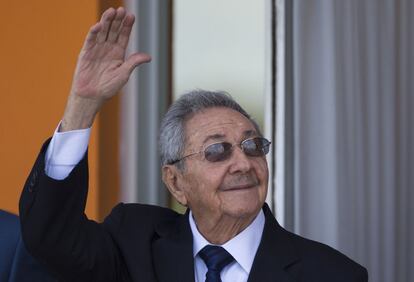Cuba returns US missile shipped to Havana by accident
Hellfire air-to-surface device was used during NATO training exercises in Spain

An inert Hellfire training missile belonging to the United States, which was mistakenly sent to Cuba from Europe in 2014, was returned to Washington on Saturday by authorities in Havana.
The US government had been trying to recover the missile for more than a year because it feared that its technology would be shared with countries such as North Korea or Russia.
But the thawing of bilateral relations between Cuba and the United States made it possible for the missile to be returned in one piece.
“We can say, without getting into specifics, that the inert training missile has been returned with the cooperation of the Cuban government,” said US State Department spokesman Mark Toner. In a statement, he credited the re-establishment of diplomatic relations and the reopening of the US embassy in Havana, which allowed Washington to discuss with Cuba “'issues of mutual interest.”
The government of Raúl Castro also confirmed in a statement that the missile had been given to US officials on Saturday.

Cuba explained that the missile had was shipped to the island as a result of an “error or mishandling in its country of origin.” It was discovered during a routine customs check of a cargo plane that had arrived from Paris in June 2014.
The 40-kilo Hellfire, manufactured by Lockheed Martin, is a laser-guided, air-to-surface missile which can be used in helicopters or drones.
The United States sent it to Europe to be used in NATO training exercises in Spain. Lockheed Martin had sent it to Rota military base in Cádiz from Orlando, Florida with the State Department’s approval.
After it was used in the NATO training, the missile, which did not contain any explosives, was transported by land from Cádiz to Madrid. It was supposed to be shipped to Frankfurt where it would continue on a journey to Orlando.
But for some unknown reason, the missile was placed on board an Air France flight to Paris, where it was later shipped on another flight to Havana, where it would remain for more than a year.
English version by Martin Delfín.
Tu suscripción se está usando en otro dispositivo
¿Quieres añadir otro usuario a tu suscripción?
Si continúas leyendo en este dispositivo, no se podrá leer en el otro.
FlechaTu suscripción se está usando en otro dispositivo y solo puedes acceder a EL PAÍS desde un dispositivo a la vez.
Si quieres compartir tu cuenta, cambia tu suscripción a la modalidad Premium, así podrás añadir otro usuario. Cada uno accederá con su propia cuenta de email, lo que os permitirá personalizar vuestra experiencia en EL PAÍS.
¿Tienes una suscripción de empresa? Accede aquí para contratar más cuentas.
En el caso de no saber quién está usando tu cuenta, te recomendamos cambiar tu contraseña aquí.
Si decides continuar compartiendo tu cuenta, este mensaje se mostrará en tu dispositivo y en el de la otra persona que está usando tu cuenta de forma indefinida, afectando a tu experiencia de lectura. Puedes consultar aquí los términos y condiciones de la suscripción digital.
More information
Últimas noticias
Maduro pleads not guilty before the federal court in New York: ‘I am still the president of Venezuela’
A new test can detect Alzheimer’s from a finger prick
UN team enters Sudanese city of El Fasher after paramilitary massacre: ‘It’s like a ghost town’
A recipe for resistance: Indigenous peoples politicize their struggles from the kitchen
Most viewed
- Gilles Lipovetsky: ‘If you want to live better and fall in love, take Prozac, don’t look to philosophy’
- Alain Aspect, Nobel laureate in physics: ‘Einstein was so smart that he would have had to recognize quantum entanglement’
- Maduro’s downfall puts China’s relationship with Venezuela to the test
- Why oil has been at the center of Venezuela-US conflicts for decades
- Alvin Hellerstein, a 92-year-old judge appointed by Bill Clinton, to preside over Maduro’s trial in New York










































